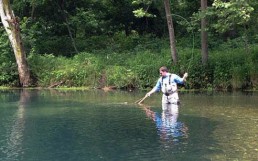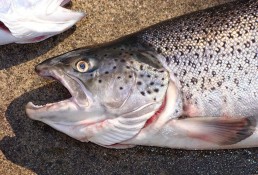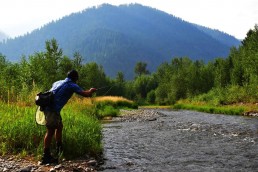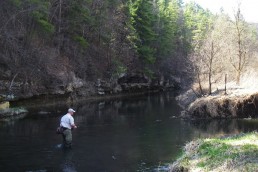Read the Stream and Take its Temperature to Catch Trout
SHARE THIS POST
If you are going to catch trout, the first thing you need to do is locate where they are on the day you are out on the stream. Many times you can go out on a stream and catch trout in a certain stretch of water or in a certain hole, and the next time you go out there is nothing biting. Some people think it is because the trout have been fished out, while others think it is just that the trout are not feeding.
It could be a little of both, but not necessarily either one. A lot of it is going to have to do with water temperature.
First, let’s look at reading the stream for the trout.
When we go out in the spring, finding trout is fairly easy. The streams are all cool and there will be trout in virtually every stretch of flat water. However, in the more shallow areas of flat water, you will find mostly the smaller trout. The big guys chase them from the prime spots and there is plenty of food coming down the stream anyway so they do their feeding wherever they can. In the spring when the water is fairly high, the big ones will not necessarily be in the deepest holes. Spot that large rock in the stream where the water is splitting and going around both sides and you will probably find a good-sized trout. Usually they will be lying just to the downstream side of the rock, out of the current. However, if it is a large enough rock they may be lying just in front of the rock. This is because the water is splitting a decent distance from the rock and there is a “calm” in front of it. To lie behind this type of rock the trout would miss some food because it would be too far out to the side. And remember, trout always lay facing upstream to see their food as it approaches.
Another great spot in the spring is either the head or the tail of a rapids. The head of the rapids, just before the water gets too turbulent, there is usually trout to be had. They know that the food will be coming and they wait for it there. The tail of the rapids is probably a little better because the trout are waiting there for whatever washes down through the rapids. One of the tricks that worm fishers use is to flip their worm into the rapids and just let it float down. Usually, as the worm gets to the end of the rapids and just about into the deep still pool below the rapids, they have a trout on.
There are other excellent spots to look for trout. The outside of a bend in the stream where the water slows down is usually good. This is another spot where the fish food is washed into the area and the trout have easy picking. Under overhanging brush is another, as trout lay there waiting for insects to fall from the brush. Deep holes can be good, but I have found that in the early spring they may not be as good as later in the spring or the summer.
Are you enjoying this post?
You can be among the first to get the latest info on where to go, what to use and how to use it!
So, where do all of these trout go after the first month or so of the season?
Well, there is a tool that you can get to tell you where you will have a better chance—a stream thermometer. When I purchased my first one it cost just under $5. Now that same thermometer will run you between $10 and $15. Trout are very temperature-sensitive, so having a thermometer is almost a necessity if you are going to be successful. One of the reasons that deep holes—especially spring holes—may not be good in the early spring is that if the water temperture is 40 degrees or less, trout won’t feed. Once the water gets over 75 degrees, it has lost so much of the oxygen needed for trout that they become very lethargic. Trout prefer water from 45 degrees up to 75 degrees. Browns are more comfortable at the upper end of the temperature scale than brookies. On the other hand, brookies are more tolerant of the colder temps than browns or rainbows. Looking through my old notes, I find that the best temps for catching trout ranges from 58 to 61 degrees.
This is where the stream thermometer comes in handy. If you check out that deep hole on opening weekend you may find that the water temp is only 38 or 39 degrees. You will not have to waste time fishing that hole, as even brookies probably won’t hit at that temp. On the other hand, by midsummer temps in that hole may be 60 degrees or so, and should be a hot spot.
Another thing to look for is the amount of oxygen in the water. This is not something you can test, but you can tell by looking. If you take the water temp and it is in the upper range for trout, but is rapidly moving over rocks and down slight slopes, it probably has enough oxygen. But if it is at that upper range and is totally still, it probably is a little short on oxygen. I find that in the lat spring and summer trout are grouped closer together. This is especially in the smaller streams. They tend to congregate where the right temperature and oxygen levels are. The more shallow, flat stretches of water are almost useless to fish; those trout that were there in the spring either got caught or moved to a better area.
Here is a tip for those early, catch-and-release-season trout fishermen. If you are out on the stream and do not have your thermometer, look for areas where steam is coming off the water. These will be the warmest areas of the stream and the best places to try for trout.
I will be the first to admit that I do not always use my thermometer, but I should. I tend to use it more when I am fishing a stream for the first couple of times, but neglect it when I am on familiar streams. I could probably do even better if I used the thermometer all the time. When you catch all of those trout, keep enough for a meal and put the rest back for someone else to enjoy.
MWO
SHARE THIS POST
Did you enjoy this post?
You can be among the first to get the latest info on where to go, what to use and how to use it!




